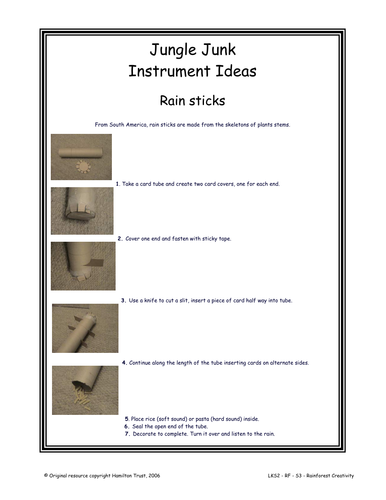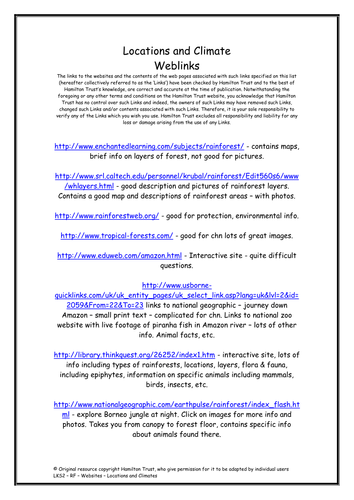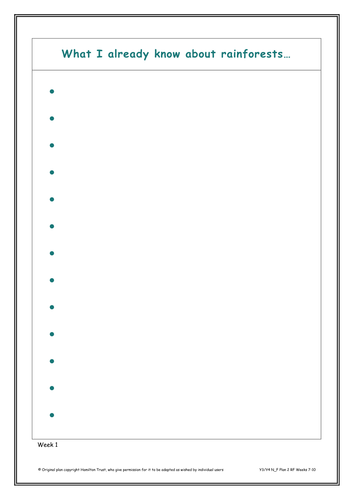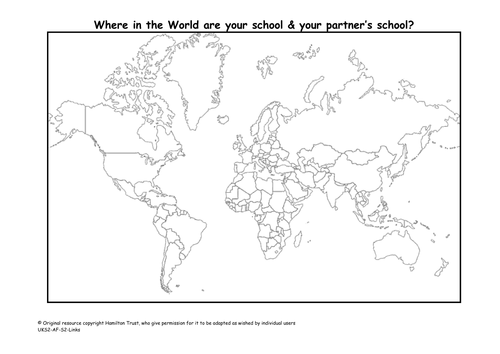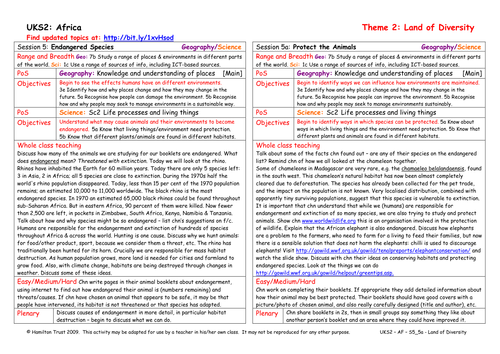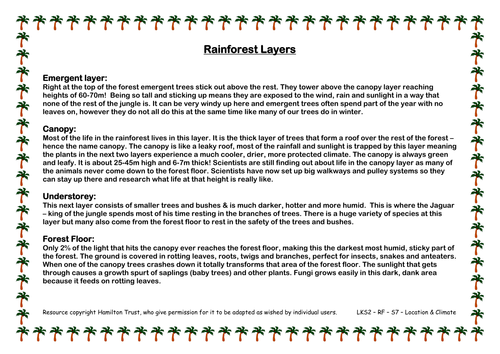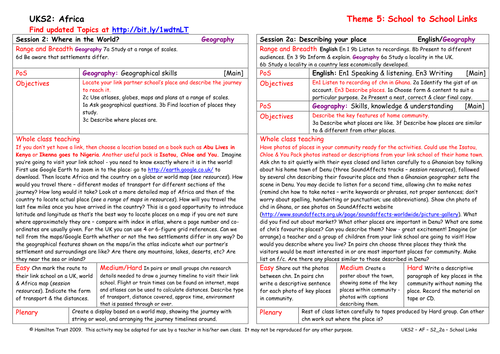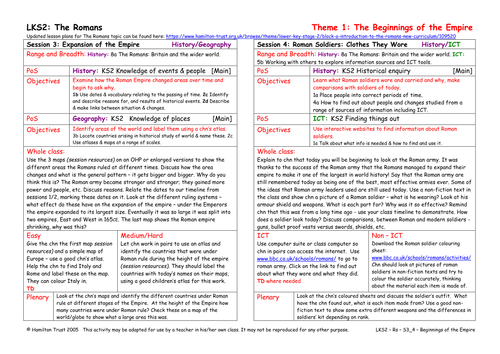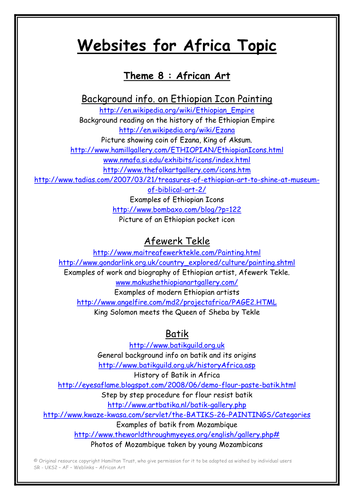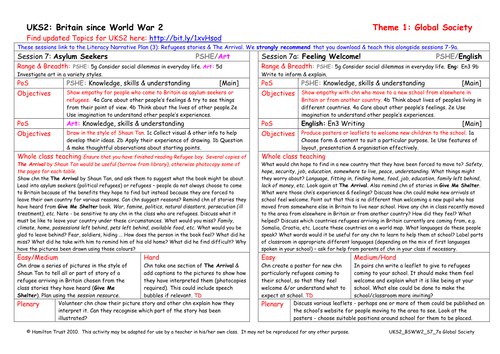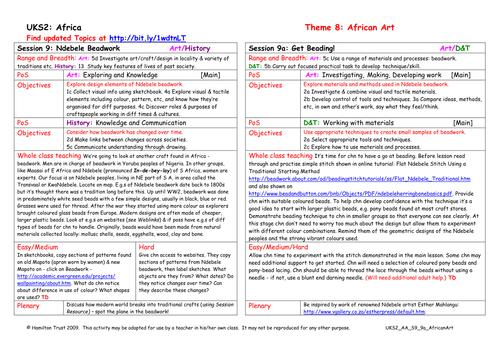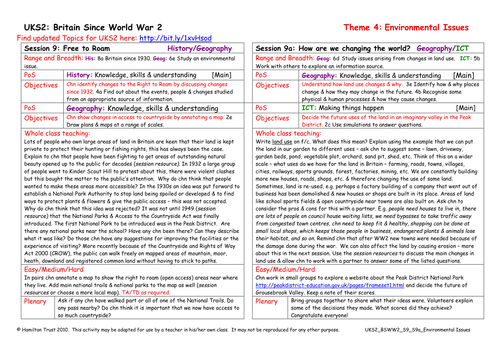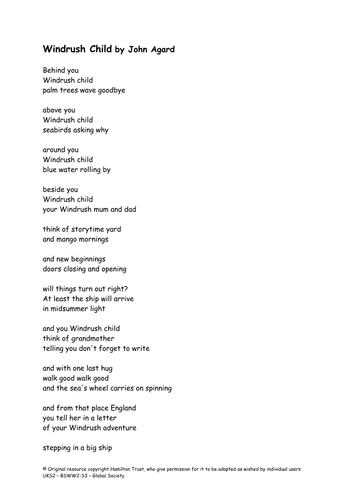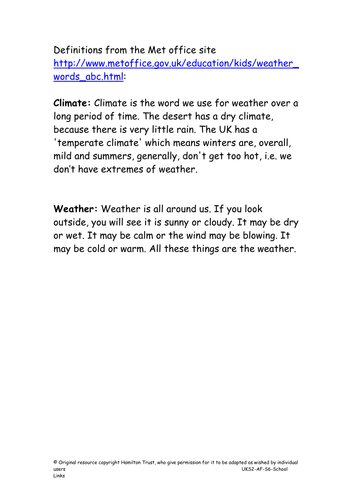
3k+Uploads
10008k+Views
11616k+Downloads
Geography

Jungle Junk
Listen to the Rhythm of the Rainforest in this session! Children start by studying the Baka people who live in the African Rainforests, looking in detail at their instruments. Children then create simple instruments of their own using junk modelling techniques.

Locating Rainforests on world map
In this session children look at a globe to identity the equator, before finding the tropics of Capricorn and Cancer. They find out that the worlds rainforests lie between these lines and name each continent.
Suitable for Years 3 and 4.
Find other lesson plans and resources at www.hamilton-trust.org.uk.

Rainforests - Information Texts Weeks 7 - 10
Children have many opportunities to explore different styles and ways of presenting information texts. They note key features and move on to research and create their own rainforest layers book. Then finally they design web pages using the Hamilton WebLearner.
Suitable for years 3 and 4.
Find other lesson plans and resources at www.hamilton-trust.org.uk.

Rainforests - Creating Images weeks 1 - 2
This poetry unit allows children to explore the wonderful array of rainforest animals. They use two poetry books to explore different features and go on to use these as structures their own poems. They have fun performing their poems to other children in the school
Suitable for years 3 and 4.

From Romans To Save The Children
Children continue work on health and hygiene in relation to clean water and the diseases caused/transmitted by dirty water. Using the Save the Children website, children discover the ways in which this issue is being tackled in different parts of the world.
Suitable for years 3 and 4.

Where in the World?
Discover where in Africa your link school is (or use a child described in a book as your link). Imagine you are going to visit and plan the journey you would make. Draw the route on maps or create a journey timeline including distances, mode of travel, etc.
Suitable for years 5 and 6.

Is it sinking in! Rain into Earth
In this session children find out how the rain drops that fall from the clouds get back to the rivers and seas so that the cycle can start again. Children test a variety of natural Earth surfaces to see which allows water to flow through the fastest.
Suitable for years 3 and 4.

We Are Britain
We all have at least one thing in common – we live in Britain! Chn meet lots of different chn from all over the UK courtesy of We are Britain by B. Zephaniah. They see people move around the UK & other countries é they think about their own histories.
Suitable for Years 1 é 2.

Protect the Animals
Children complete their projects on African animals. They include advice or information about how their animal can be protected, drawing on World Wildlife Fund sites and advice. They proudly display their finished booklets! Suitable for years 5 and 6.
Find other lesson plans and resources at www.hamilton-trust.org.uk.

Layers of the Rainforest
Children take a journey from the gloom of the forest floor to the bright sunshine at the top of the tallest tree, as they learn about the layers of vegetation. Children then use the internet and non-fiction books to find out more about a layer.
Suitable for years for 3 and 4.
Find other lesson plans and resources at www.hamilton-trust.org.uk.

Describing Your Place
Listen carefully to some children in Ghana describing their home town or use descriptions from your link school friends of their town. Imagine the teacher and some children from your link school are going to visit your town! Describe the places they should visit.
Suitable for years 5 and 6.

Expansion of the Empire
Children look at how the Roman Empire expanded over a period of 400 years and then began to diminish in extent. They relate this to the systems of government identified in Session 2. They map the Roman Empire on today’s world map, identifying countries.
Suitable for years 3 and 4.

Creative Designs
Applying their knowledge of Mozambique batik, children plan and design a wall hanging. Children sketch their designs bearing in mind the techniques of batik and the need for clear, simple images.

Beautiful Batik
Focus on the beautiful batik found in Mozambique. Explore the visual and tactile elements, including use of colour and pattern.
Children use sketchbooks to copy and explore sections of these designs concentrating on composition and subject matter.

Ethiopian Icon Painting
Take a trip back in time to introduce art of icon painting from ancient kingdom of Ethiopia.
Children explore features of this art form and consider how they were painted and their purpose. They copy small areas of icons to capture style elements.

Asylum Seekers
Explain that some people come to Britain as asylum seekers or refugees to escape from problems in their home country. Use The Arrival by Shaun Tan to empathise with people coming to Britain. Children draw part of one of short stories from Give me Shelter.

Ndebele Beadwork
Zooming in on South Africa, children are introduced to the incredible beadwork of the Ndebele people of KwaNdebele.
Through web images children explore the history of this craft and investigate its key visual elements.

Free To Roam
In the past landowner’s have not wanted people to have access to their land. Children look at how the introduction of National Parks and Access to the Countryside Act 1949 has changed this. Children annotate a map showing ‘right to roam’ areas, trails, etc.

Windrush
Read the poem Windrush Child by John Agard and get children’s reactions. Give brief history of SS Windrush’s journey to Britain in 1948. Children either mark the journey on a map or answer questions about photographs to do with Caribbean immigration on the Windrush.

Climate
Investigate the climate of the UK and different parts of Africa. Consider how the weather affects our daily lives – clothes, homes, transport, food, etc. Keep a weather chart to swap with your link school or research climate change in UK and Africa.
Suitable for years 5 and 6.

